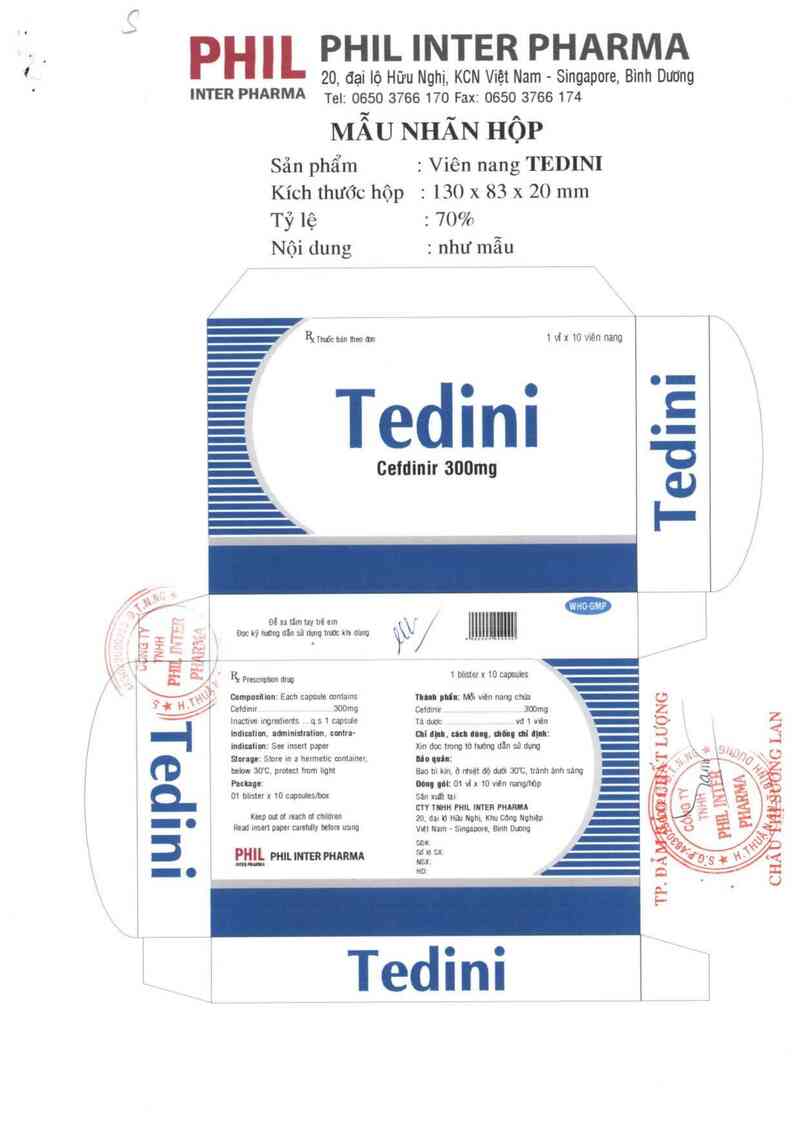
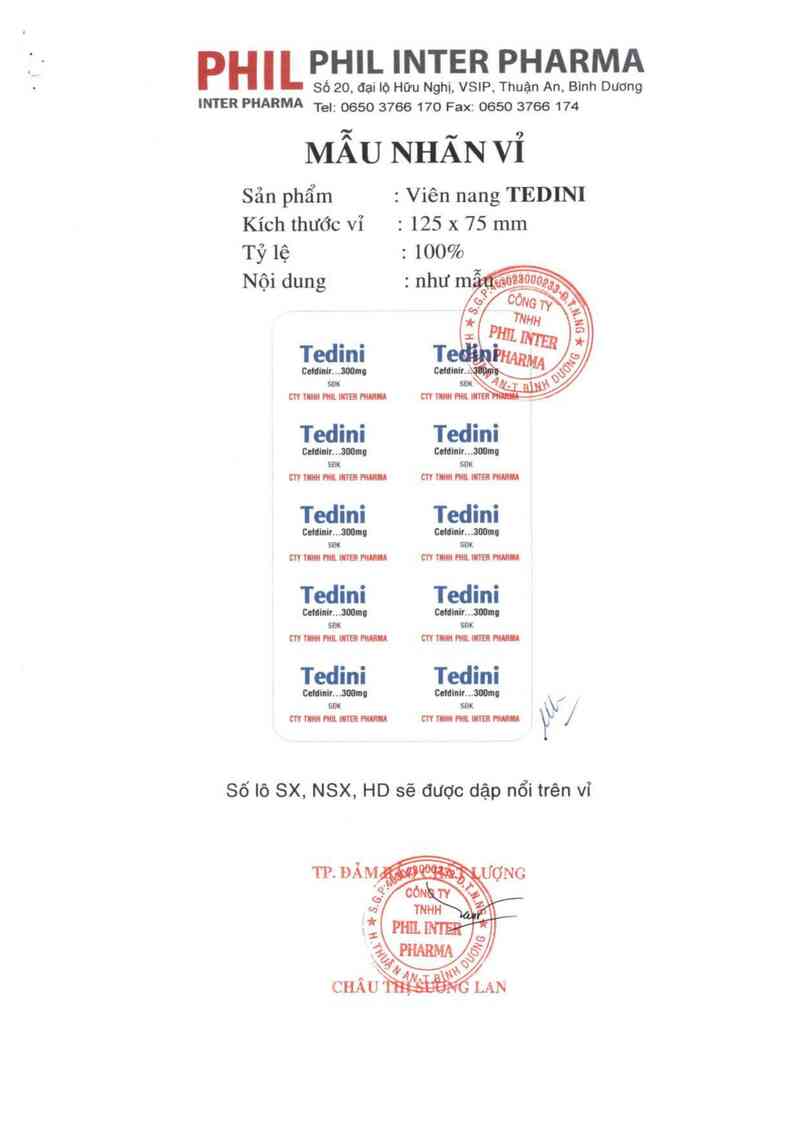
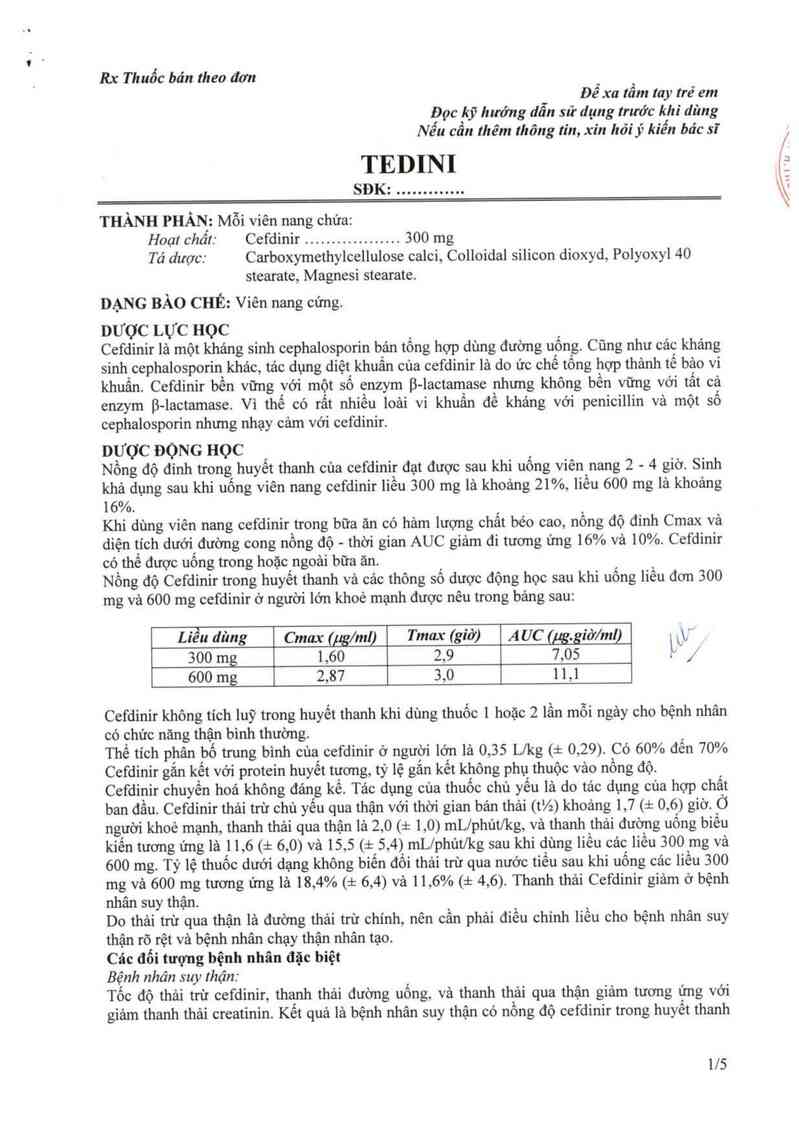
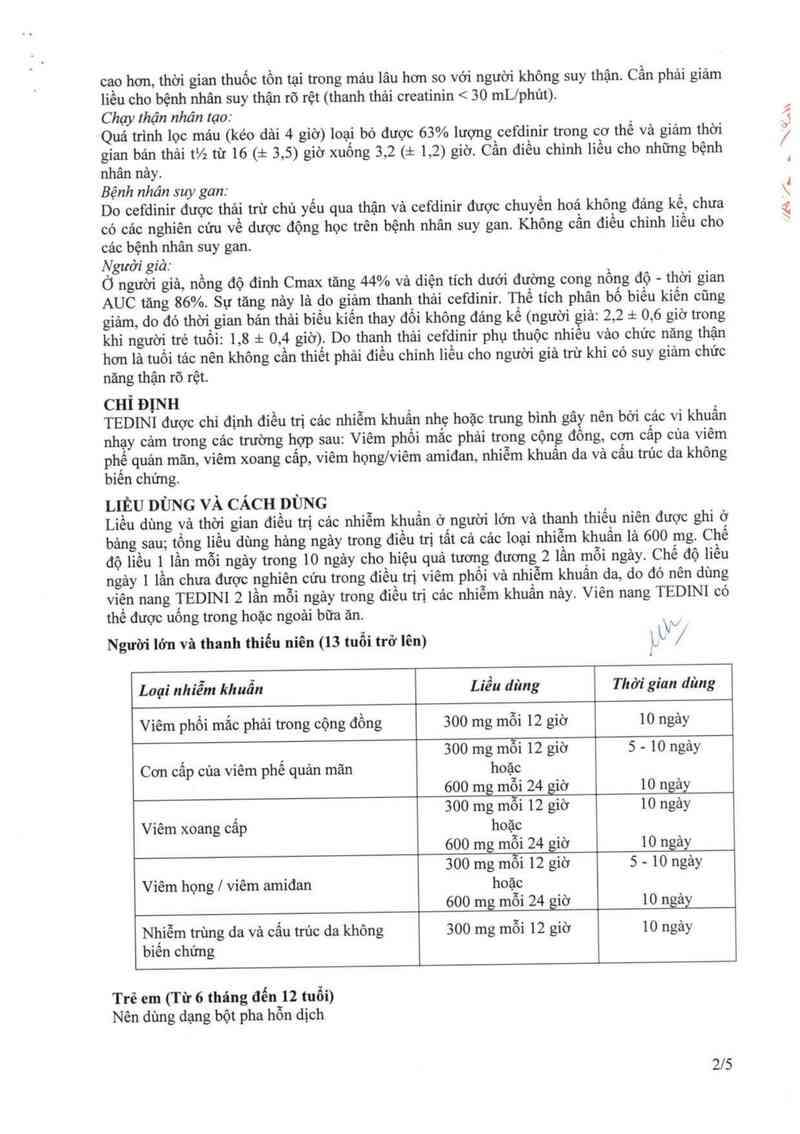
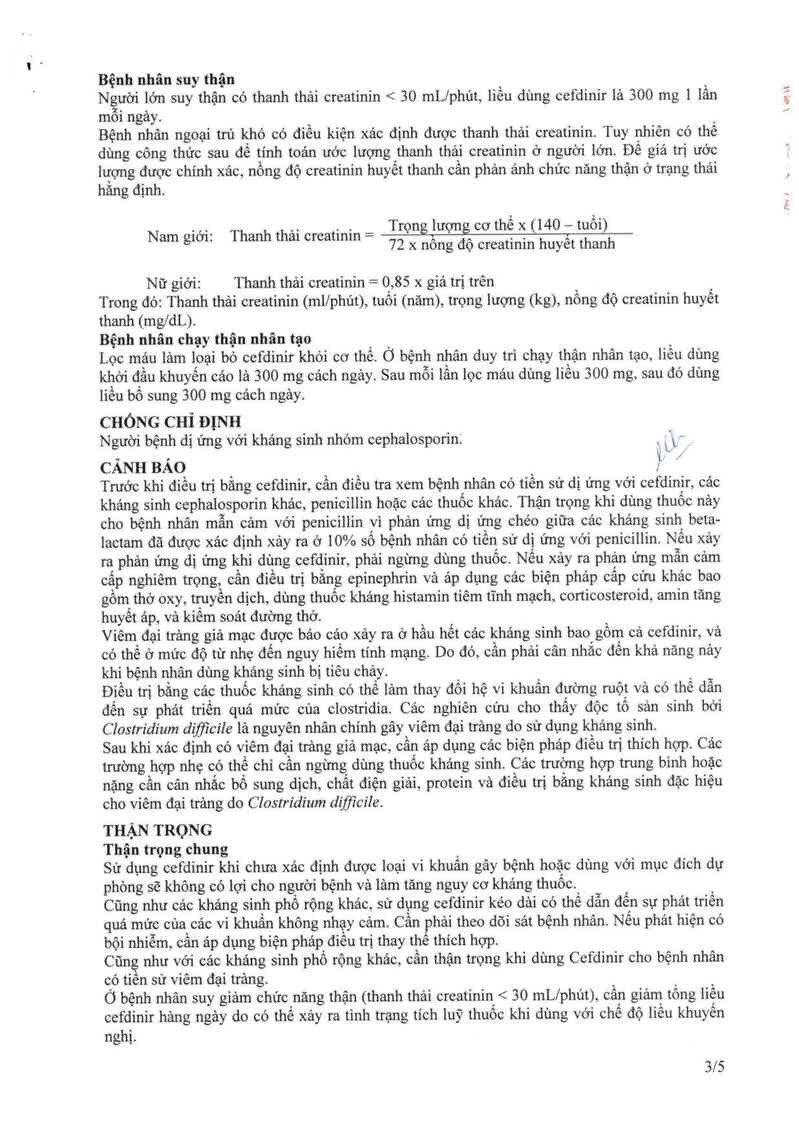
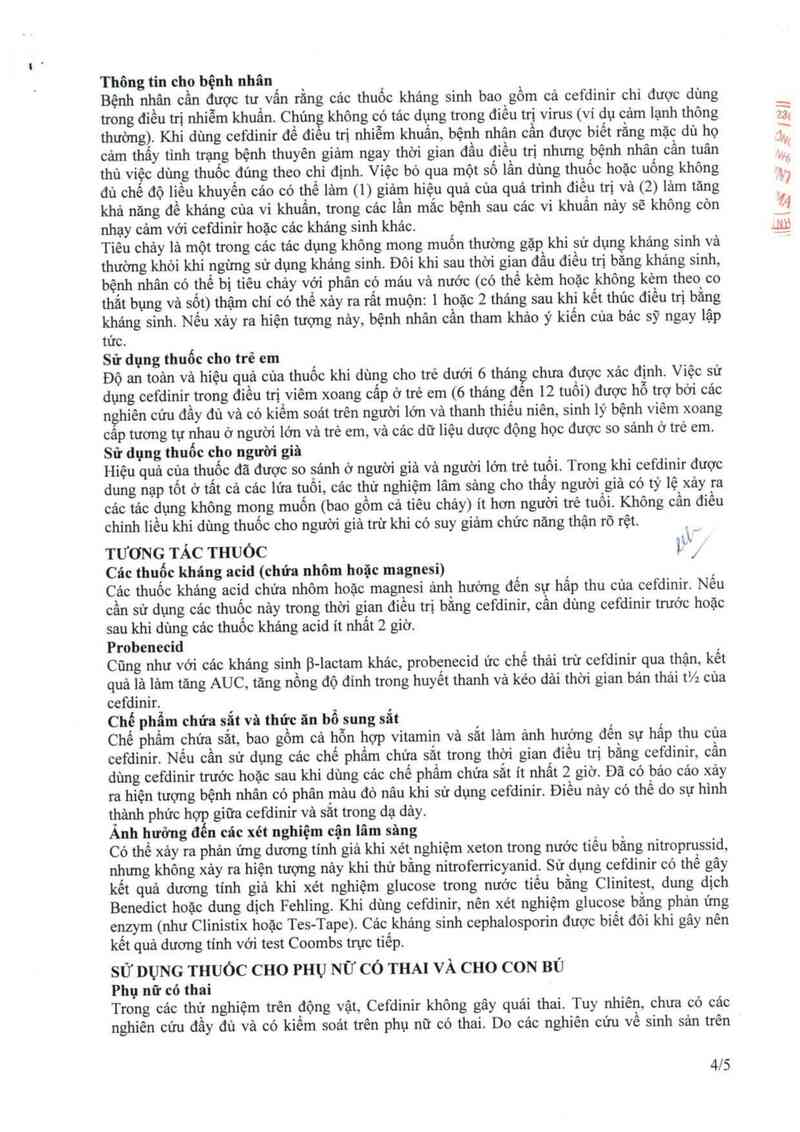
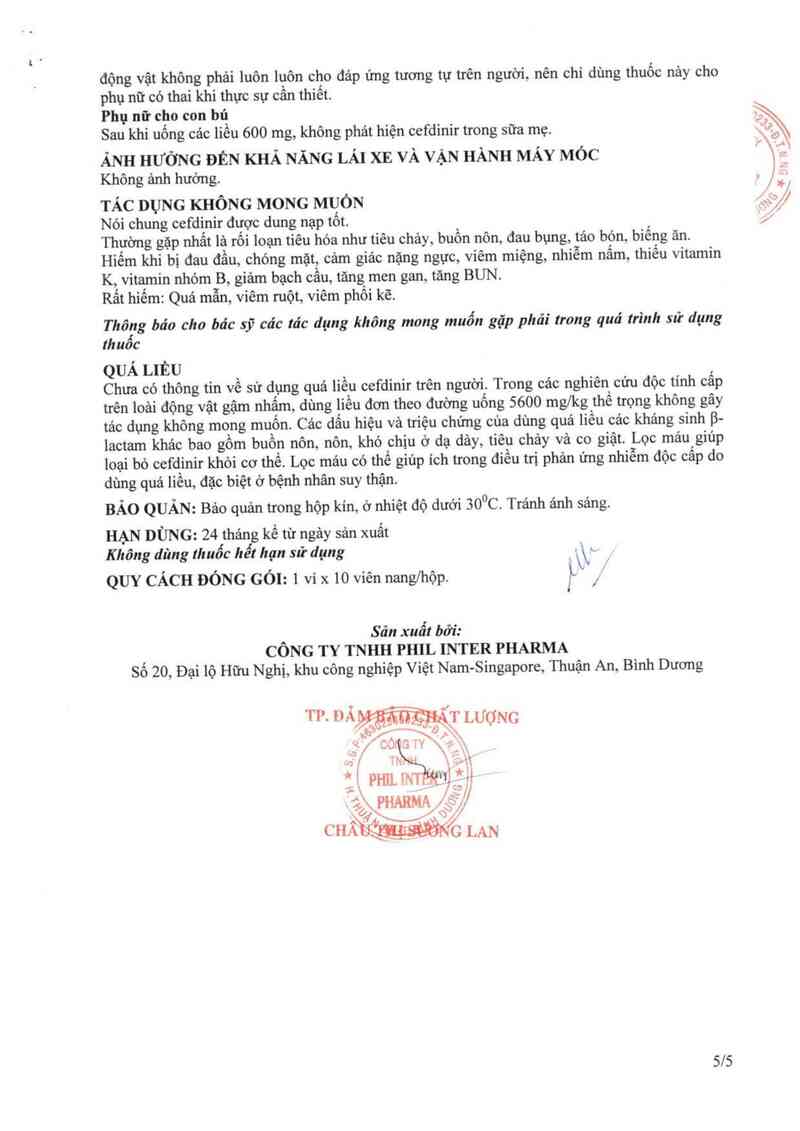
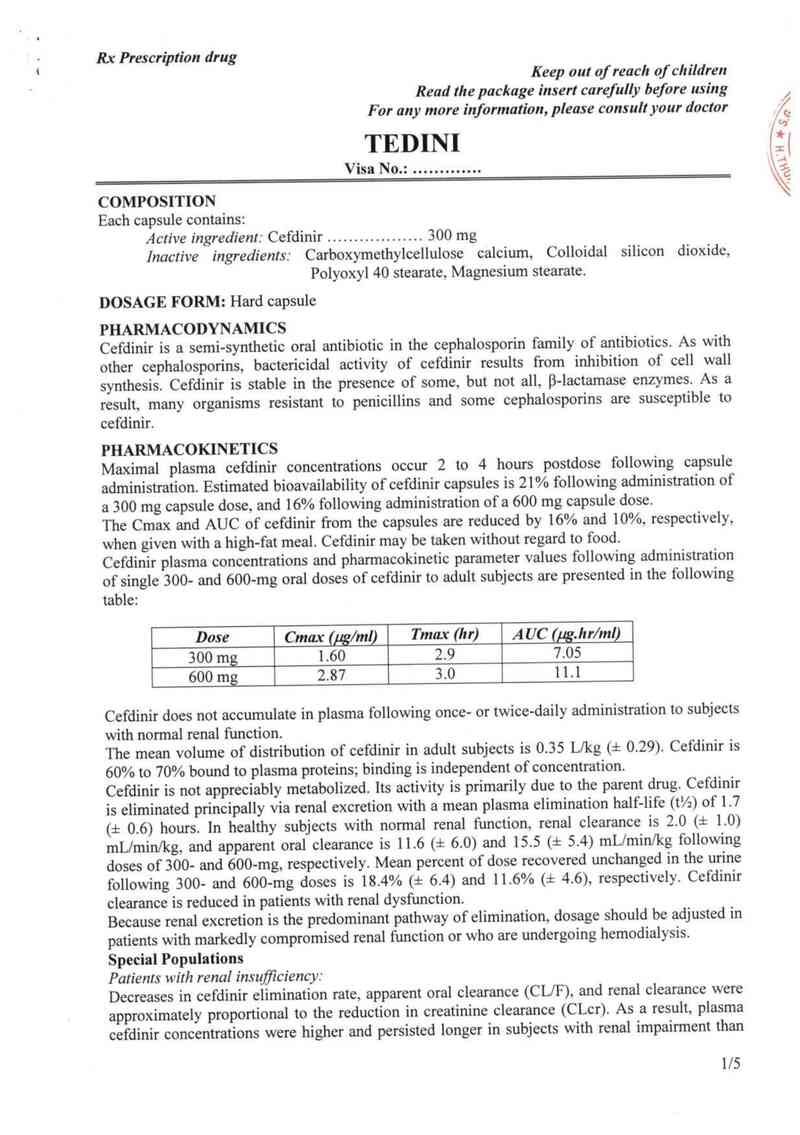
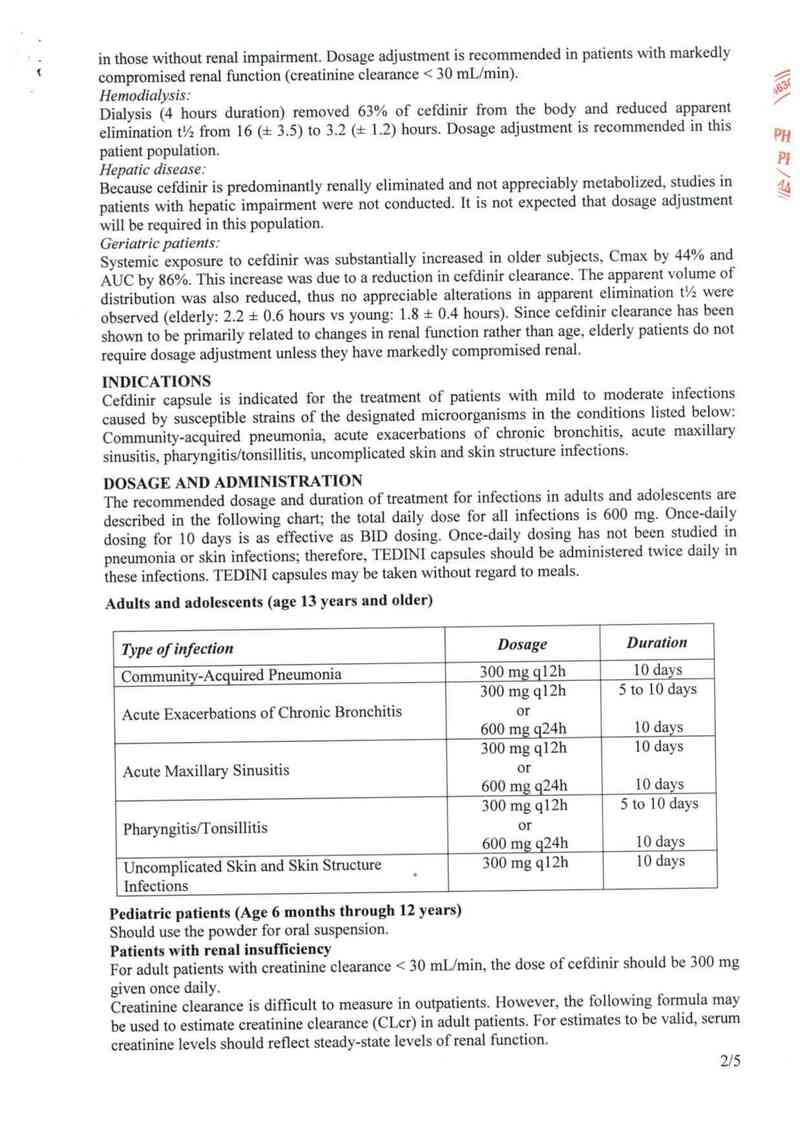
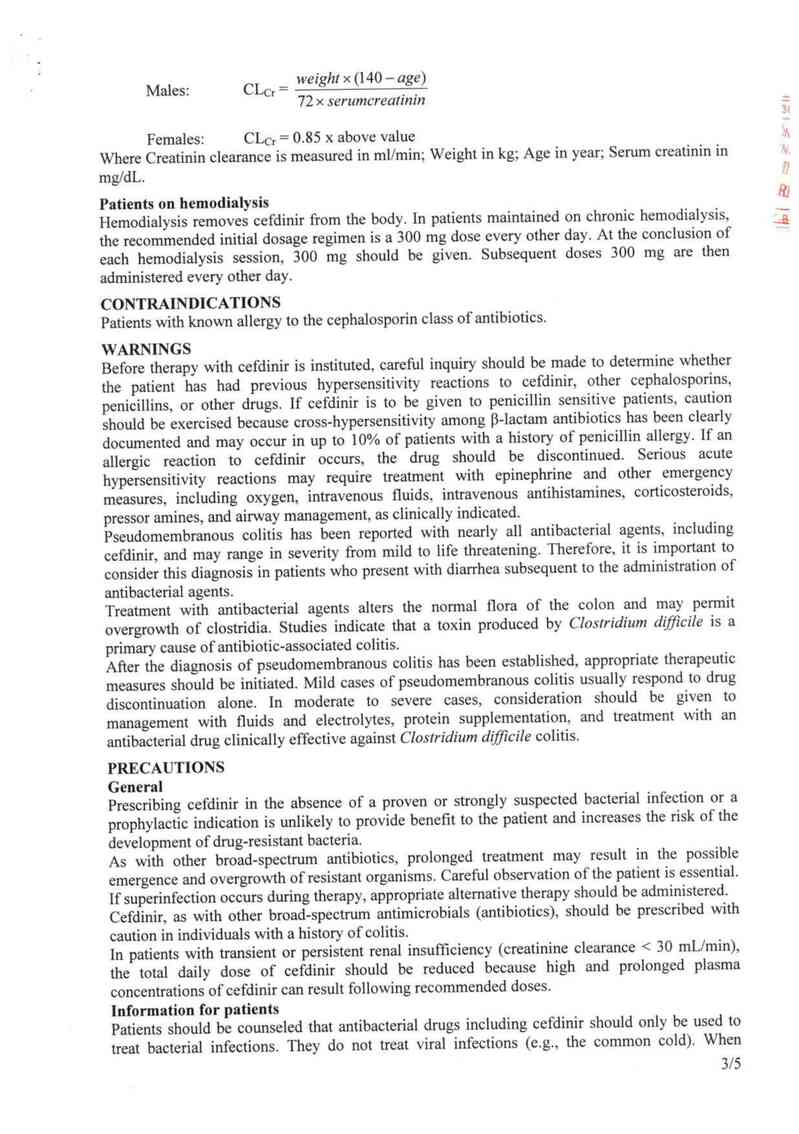
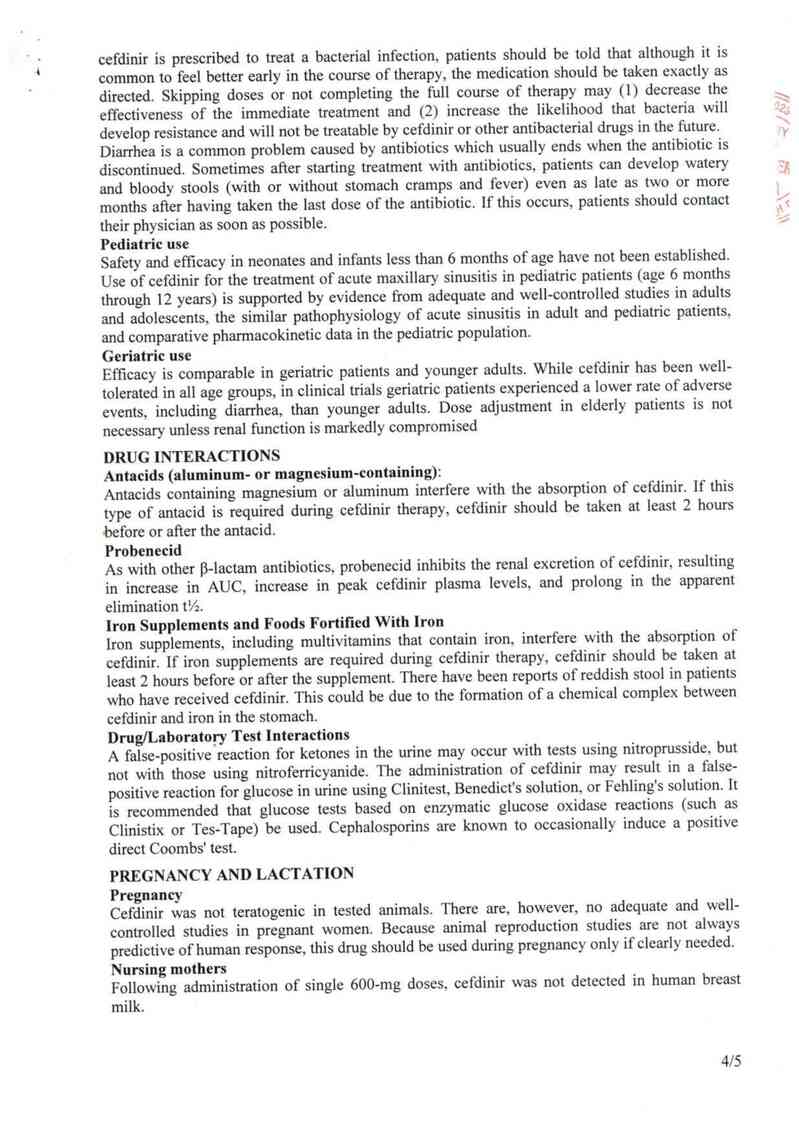
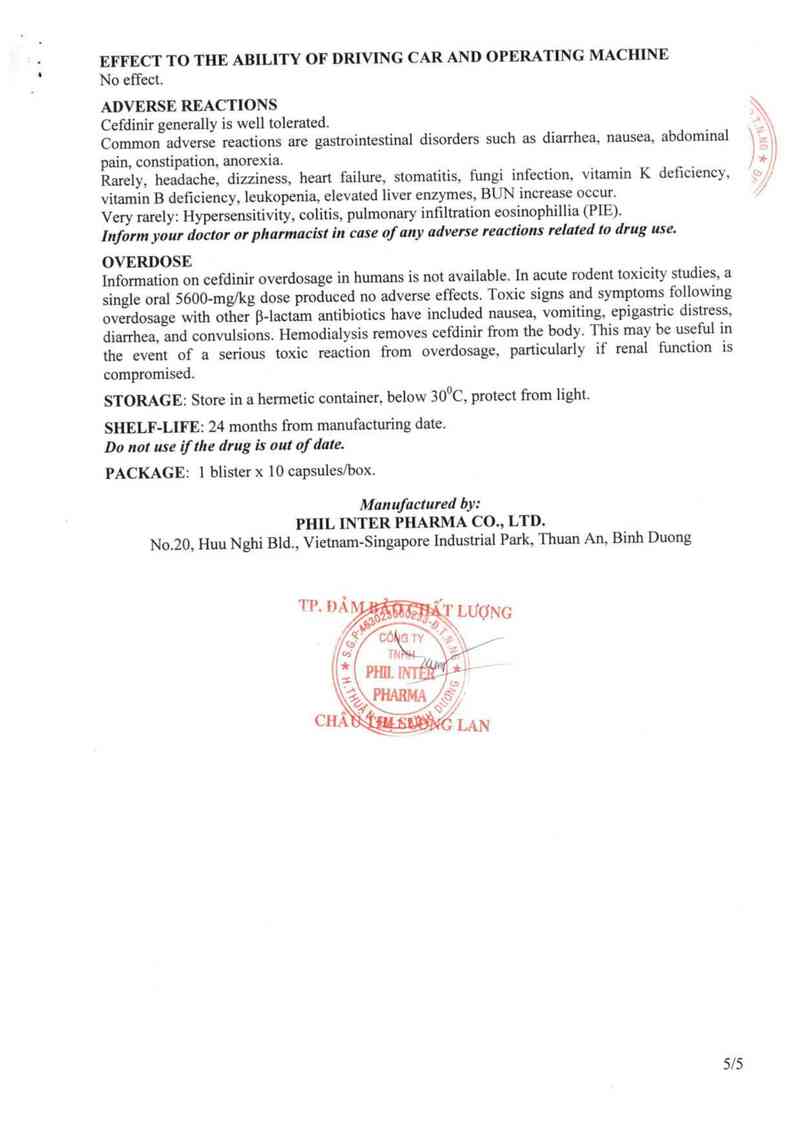
\fN
PH | L PHIL INTER PHARMA
20, đại lộ Hữu Nghị, KCN Việt Nam - Singapore, Bình Dương
'NTER PHARMA Tel: 0650 3766 170 Fax: 0650 3766 174
MÂU NHÃN HÔP
Săn phẩm : Viên nang TEDINI
Kích thước hộp : 130 x 83 x 20 mm
Tỷ lệ : 70%
Nội dung : như mẫu
RcThuỉcbán mom: 1 vi x 10 viên nang \\
.- `\
Tedini E
Ceidinir 300mg -c \
06 xa tăm tay trú em
Đoc kỹ an Mn sủ nung tnnc ku umo QỈ\_\J
" Rx Pmscnpmn m 1 bhster x 10 capsules
Oomụuilbn: Each capsule mntalns nui plll; NBi wen nang cria
Cctdum 300m0 Celdmu 3(Dmg
Inactwe mgrediema q 5 1 capsưo Ta duoc . , _ vd 1 vien
indiclliơm. lủliihidưllm. cmtn- ui lhl. m |lu_ uh. d llllĩ
lnủlullm: See msen pam Xln doc tmng tc Ming dãn sử dung
Ionol: Shu in a hanuutlt: mntamer. Ho uh:
bebw 3ƯC, prmoct tmrn Ilght Bao bi kỉn. 6 mm dò … aơc. ua… ánh sáng
Plchp: m gủl: 01 vi x 10 viên nang/hũp
01 blusler x 10 cạsuies/box Sln nít lai
` … TIMH PNIL INTER PHARMA
Keep … oi rmh d chMrm zo. uu u Hm uqm. Khu cong ugmẽo
Real msen paper aliy betort usmo vm Nam . Smgamm_ sum nm
Ẹ_IỊẺ pm mm PHARMA
PH | L PHIL INTER PHARMA
sò 20. đại lộ Hữu Nghị. VSIP. Thuận An. Binh Dương
lNTER PHARMA Tet: 0650 3766 170 Fax: 0650 3766 174
MẨU NHÃN vỉ
Sãn phẩm : Viên nang TEDINI
Kích thước vĩ : 125 x 75 mm
Tỷ lệ : 100%
Nội dung
Tedini
Cdllinir...ng
Tedini Tedini
Cdllilit. . .amm Co…nir. . .3Wlllu
Tedini Tedini
cminir. . .…lu Cltlilit. . .Smmg
Tedini Tedini
Minif. . .mu Cddlnir. ..3Mllu
Tedini Tedini
Mìllr...ffllli Cddlhir...3ng . J
t
Số lô SX, NSX, HD sẽ được dập nổi trên vỉ
Rx Thuốc bán theo đơn
Để xa tẩm tay trẻ em
Đọc kỹ hướng dẫn sử dụng trước khi dùng
Nếu cần thêm thông tỉn, xin hỏi ý kiến bác sĩ
TEDINI
SĐK: .............
THÀNH PHÀN: Mỗi viên nang chứa:
Hoạt chât: Cefdinir .................. 300 mg
Tá dược: Carboxymethylcellulose calci, Colloidal silicon dioxyd, Polyoxyl 40
stearate, Magnesi stearate.
DẠNG BÀO CHẾ: Viên nang cứng.
DƯỢC LỰC HỌC
Cefdinir là một kháng sinh cephalosporin bán tổng hợp dùng đường uống. Cũng như cảc khảng
sinh cephalosporin khảo, tảc dụng diệt khuẩn cùa cefdinir là do ức chế tổng hợp thảnh tế bảo vi
khuần. Cefdinir bền vững với một số enzym B—lactamase nhưng không bền vững với tất cả
enzym B-lactamase. Vì thế có rất nhiều loải vi khuần dề kháng với penicillin và một số
cephalosporin nhưng nhạy cảm với cefdinir.
DƯỢC ĐỌNG HỌC
Nồng độ đinh trong huyết thanh của cefdinir đạt được sau khi uống viên nang 2 - 4 giờ. Sinh
khả dụng sau khi uống viên nang cefdinir liều 300 mg là khoảng 21%, liều 600 mg là khoảng
16%.
Khi dùng viên nang cefdinir trong bữa ăn có hảm lượng chất béo cao, nồng độ đinh Cmax và
diện tích dưới đường cong nồng độ - thời gìan AUC giảm đi tương ứng 16% và 10%. Cefdinir
có thể được uống trong hoặc ngoải bữa ăn.
Nồng độ Cefdinir trong huyết thanh và cảc thông số dược dộng học sau khi uống liều đơn 300
mg và 600 mg cefdinir ở người lớn khoẻ mạnh được nêu trong bảng sau:
Liều dùng Cmax (ụg/m!) Tmax (giờ) A UC (pg.gỉờ/ml) ừj
300 mg 1,60 2,9 7,05 ị /
600 mg 2,87 3,0 11,1
Cefdinir không tích luỹ trong huyết thanh khi dùng thuốc 1 hoặc 2 lần mỗi ngảy cho bệnh nhân
có chức năng thận bình thường.
Thể tích phân bố trung binh của cefdinir ở người lớn là 0,35 L/kg (:t 0,29). Có 60% đến 70%
Cefdinir gắn kểt với protein huyết tương, tỷ lệ gắn kết không phụ thuộc vảo nồng độ.
Cefdinir chuyền hoá không đáng kề. Tảc dụng cùa thuốc chủ yếu là do tảc dụng của hợp chất
ban đầu. Cefdinir thái trừ chủ yếu qua thận vởi thời gian bản thải (tVz) khoảng 1,7 (i 0,6) giờ. Ở
người khoẻ mạnh, thanh thải qua thận là 2,0 (:t 1,0) mL/phủt/kg, và thanh thải đường uống biểu
kiến tương ứng là 11,6 (i 6,0) và 15,5 (:t 5,4) mL/phủt/kg sau khi dùng iiều các liều 300 mg và
600 mg. Tỷ lệ thuốc dưới dạng không biến đồi thải trừ qua nước tiểu sau khi uống cảc liều 300
mg và 600 mg tương ứng là 18,4% (i 6,4) và 11,6% (i 4,6). Thanh thải Cefdinir giảm ở bệnh
nhân suy thận.
Do thải trừ qua thận là đường thải trừ chính, nên cần phải điều chỉnh liều cho bệnh nhân suy
thận rõ rệt và bệnh nhân chạy thận nhân tạo.
Các đối tượng bệnh nhân đặc biệt
Bệnh nhân suy rhận:
Tốc độ thải trừ cefdinir, thanh thải đường uống, và thanh thải qua thận giảm tương ứng với
giảm thanh thải creatinin. Kết quả là bệnh nhân suy thận có nồng ơộ cefdinir trong huyết thanh
1/5
cao hơn, thời gian thuốc tồn tại trong mảu lâu hơn so với người không suy thận. Cần phải giảm
liều cho bệnh nhân suy thận rõ rệt (thanh thải creatinin < 30 mL/phủt).
Chạy thận nhăn tạo:
Quá trình iọc máu (kéo dải 4 giờ) loại bỏ được 63% lượng cefdinir trong cơ thể và giảm thời
gian bán thải tVz từ 16 (3: 3,5) giờ xuống 3,2 (i 1,2) giờ. Cần điều chinh liều cho những bệnh
nhân nảy.
Bệnh nhân suy gan:
Do cefdinir được thải trừ chủ yếu qua thận và cefdinir được chuyển hoá không đảng kế, chưa
có cảc nghiên cứu về dược động học trên bệnh nhân suy gan. Không cần điều chỉnh liếu cho
cảc bệnh nhân suy gan.
Người giâ:
0 người giả, nồng độ đinh Cmax tăng 44% và diện tích dưới đường cong nồng độ - thời gian
AUC tăng 86%. Sự tãng nảy là do giảm thanh thải cefdinir. Thể tích phân bố biền kiến cũng
giảm, do đó thời gian bản thải biểu kiến thay đổi không đáng kể (người giả: 2,2 :1: 0,6 giờ trong
khi người trẻ tuối: 1,8 ả: 0,4 giờ). Do thanh thải cefdinir phụ thuộc nhiêu vảo chức năng thận
hơn là tuổi tảc nên không cấn thiết phải điều chinh liều cho người giả trừ khi có suy giảm chức
năng thận rõ rệt.
CHỈ ĐỊNH
TEDINI được chỉ định điều trị cảc nhiễm khuấn nhẹ hoặc trung bình gây nên bởi cảc vi khuấn
nhạy cảm trong các trường hợp sau: Viêm phôi măc phải trong cộng đông, cơn câp cùa viêm
phế quản mãn, viêm xoang cấp, viêm họng/viêm amiđan, nhiễm khuẩn da và cấu trúc da không
biến chứng.
LIÊU DÙNG VÀ CÁCH DÙNG ,
Liều dùng và thời gian điều trị cảc nhiễm khuẩn ở người lởn và thanh thiên niên được ghi ở
bảng sau; tống liều dùng hảng ngảy trong điều trị tất cả cảc loại nhiễm khuẩn lả 600 mg. Chế
độ iiều 1 lần mỗi ngảy trong 10 ngảy cho hiệu quả tương đương 2 iần mỗi ngảy. Chế độ liều
ngảy 1 lần chưa được nghìên cứu trong điểu trị viêm phối và nhiễm khuấn da, do dó nên dùng
viên nang TEDINI 2 lần mỗi ngảy trong diểu trị các nhiễm khuẩn nảy. Viên nang TEDTNI có
thể được uống trong hoặc ngoảì bữa ăn.
Người lởn và thanh thiếu niên (13 tuổi trở lên) Ư*` /
Loại nhiễm khuẩn Liều dùng T hời gian dùng
Viêm phổi mắc phải trong cộng đồng 300 mg mỗi 12 giờ 10 ngảy
' 300 mg mỗi 12 giờ 5 … 10 ngảy
Cơn câp của viêm phế quản mãn hoặc
600 mg mỗi 24 giờ 10 ngảy
. 300 mg mỗi 12 giờ 10 ngảy
Viêm xoang câp hoặc
600 mg mỗi 24 giờ 10 ngảy
300 mg mỗi 12 giờ 5 - 10 ngảy
Viêm họng | viêm amiđan hoặc
600 mg mỗi 24 giờ 10 ngảy
Nhiễm trùng da và cấu trúc da không 300 mg mỗi 12 giờ 10 ngảy
biên chứng
Trẻ em (Từ 6 tháng đến 12 tuổi)
Nên dùng dạng bột pha hỗn dịch
2/5
… \ Ọ.ụ`x\
/1~Ă /_
Bệnh nhân suy thận
Người lớn suy thận có thanh thải creatinin < 30 mL/phút, liếu dùng cefdinir lả 300 mg 1 lần
mỗi ngảy.
Bệnh nhân ngoại trú khó có điều kiện xảo định được thanh thải creatinin. Tuy nhiên có thể
dùng công thức sau để tính toán ước lượng thanh thải creatinin ở người lớn. Để giá trị ước
lượng được chính xác, nồng độ creatinin huyết thanh cần phản ảnh chức năng thận ở trạng thải
hằng định.
Trọng iượng cơ thể x (140 .“ tuối)
72 x nông độ creatinin huyêt thanh
Nam giới: Thanh thải creatinin =
Nữ giới: Thanh thải creatinin= 0,85 x giá trị trên
Trong đó: Thanh thải creatinin (ml/phủt), tuổi (năm), trọng lượng (kg), nồng độ creatinin huyết
thanh (mg/dL).
Bệnh nhân chạy thận nhân tạo
Lọc mảu lảm ioại bỏ cefdinir khỏi cơ thể. Ở bệnh nhân duy trì chạy thận nhân tạo, liều dùng
khởi đầu khuyến cảo lả 300 mg cảch ngảy. Sau mỗi lần lọc mảu dùng liếu 300 mg, sau đó dùng
liều bổ sung 300 mg cách ngảy.
CHỐNG CHỈ ĐỊNH
Người bệnh dị ứng với khảng sinh nhóm cephalosporin. _ Ổ-
CẢNH BÁO i
Trước khi điều trị bằng cefdinir, cần điều tra xem bệnh nhân có tiền sử dị ứng với cefdinir, các
kháng sinh cephalosporin khác, penicillin hoặc các thuốc khác. Thận trọng khi dùng thuốc nảy
cho bệnh nhân mẫn cảm với penicillin vì phản ứng dị ứng chéo giữa các khảng sinh beta-
lactam đã được xác định xảy ra ở 10% số bệnh nhân có tiền sử dị ứng với penicillin. Nếu xảy
ra phản ứng dị ửng khi dùng cefdinir, phải ngừng dùng thuốc. Nếu xảy ra phản ứng mẫn cảm
cấp nghiêm trọng, cần điếu trị bằng epinephrin và áp dụng các biện phảp câp cứu khác bao
gôm thờ oxy, truyền dịch, dùng thuốc khảng histamin tiêm tĩnh mạch, corticosteroid, amin tăng
huyết' ap, và kiếm soát đường thờ.
Viêm đại trảng giả mạc được bảo cảo xảy ra ở hầu hết cảc kháng sinh bao gồm cả cefdinir, và
có thể ở mức độ từ nhẹ đến nguy hiếm tính mạng Do đó, cân phải cân nhắc đến khả năng nảy
khi bệnh nhân dùng kháng sinh bị tiêu chảy.
Điều trị bằng các thuốc khảng sinh có thế lảm thay đổi hệ vi khuẩn đường ruột và có thể dẫn
đến sự phát triền quá mức của clostridia. Các nghiên cứu cho thấy độc tố sản sinh bời
Clostridium difflcile lá nguyên nhân chính gây viêm đại trảng do sử dụng khảng sinh.
Sau khi xảc định có viêm đại trảng giả mạc, cần áp dụng cảc biện phảp điều trị thích hợp. Cảo
trường hợp nhẹ có thể chỉ cần ngừng dùng thuốc khảng sinh. Các trường hợp trung bình hoặc
nặng cân cân nhắc bổ sung dịch, chất điện giải, protein và điếu trị bằng khảng sinh đặc hiệu
cho viêm đại trảng do Clostridium díjfỉcile.
THẶN TRỌNG
Thận trọng chung
Sử dụng cefdinir khi chưa xảc định được loại vi khuấn gây bệnh hoặc dùng vởi mục đich dự
phòng sẽ không có lợi cho người bệnh và iâm tăng nguy cơ khảng thuốc.
Cũng như cảc kháng sinh phố rộng khảc, sử dụng cefdinir kéo dải có thể dẫn đến sự phảt triến
quá mức cùa các vi khuấn không nhạy cảm. Cần phải theo dõi sảt bệnh nhân. Nếu phảt hiện có
bội nhiễm, cẩn ảp dụng biện phảp điều trị thay thế thich hợp.
Cũng như với cảc kháng sinh phố rộng khác, cần thận trọng khi dùng Cefdinir cho bệnh nhân
có tiên sử viêm đại trảng.
Ở bệnh nhân suy giảm chức năng thận (thanh thải creatinin < 30 mL/phủt), cần giảm tống liều
ccfdinir hảng ngảy do có thể xảy ra tình trạng tích iuỹ thuốc khi dùng với chế độ liều khuyến
nghị.
3/5
xơ.i\
Thông tin cho bệnh nhân
Bệnh nhân cần được tư vấn rằng các thuốc kháng sinh bao gồm cả cefdinir chi được dùng
trong điếu trị nhiễm khuấn. Chúng không có tảo dụng trong điếu trị vìrus (ví dụ cảm lạnh thông
thường). Khi dùng cefdinir đế điêu trị nhiễm khuẩn, bệnh nhân cần được biết rằng mặc dù họ
cảm thấy tinh trạng bệnh thuyên giâm ngay thời gian đầu điều trị nhưng bệnh nhân cần tuân
thủ việc dùng thuốc đúng theo chỉ định. Việc bỏ qua một số iần dùng thuốc hoặc uổng không
dù chế độ liều khuyến cáo có thế lảm (1) giảm hiệu quả cùa quá trình diều trị và Q) lảm tăng
khả năng đề kháng cùa vi khuẩn, trong cảc lần mắc bệnh sau các vi khuần nảy sẽ không còn
nhạy cảm với cefdinir hoặc cảc khảng sinh khảc.
Tiêu chảy là một trong các tác dụng không mong muốn thường gặp khi sử dụng khảng sinh và
thường khỏi khi ngừng sử dụng khảng sinh. Đôi khi sau thời gian đầu điều trị bằng kháng sỉnh,
bệnh nhân có thế bị tiêu chảy vởi phân có mảu vả nước (có thể kèm hoặc không kèm theo co
thắt bụng và sốt) thậm chí có thể xảy ra rất muộn: 1 hoặc 2 thảng sau khi kết thúc điều trị bằng
kháng sinh. Nếu xảy ra hiện tượng nảy, bệnh nhân cần tham khảo ý kiến cùa bác sỹ ngay lập
tức.
Sử dụng thuốc cho trẻ em
Độ an toản và hiệu quả của thuốc khi dùng cho trẻ dưới 6 thảng chưa được xác định. Việc sử
dụng cefdinir trong điều tn" viêm xoang cấp ở trẻ em (6 thảng đên 12 tuồi) được hỗ trợ bời các
nghiên cứu dầy đủ vả có kiểm soát trên người lớn và thanh thiếu niên, sinh lý bệnh viêm xoang
câp tương tự nhau ở người lớn và trẻ em, và các dữ liệu dược động học được so sánh ở trẻ em.
Sử dụng thuốc cho người giả
Hiệu quả của thuốc đã được so sánh ở người giả và người lởn trẻ tuổi. Trong khi cefdinir được
dung nạp tốt ở tất cả cảc lứa tuối, cảc thử nghiệm lâm sảng cho thấy người giả có tỷ lệ xảy ra
cảc tảc dụng không mong muốn (bao gồm cả tiêu chảy) ít hơn người trẻ tuổi. Không cần điều
chỉnh liếu khi dùng thuốc cho người giả trừ khi có suy giảm chức năng thận rõ rệt. \ 4
TƯONG TÁC THUỐC 1'“ /
Các thuốc kháng acid (chứa nhôm hoặc magnesi)
Cảc thuốc khảng acid chứa nhôm hoặc magnesi ảnh hưởng đến sự hấp thu của cefdinir. Nếu
cần sử dụng cảc thuốc nảy trong thời gian điều trị bằng cefdinir, cần dùng cefdinir trước hoặc
sau khi dùng cảc thuốc kháng acid it nhất 2 giờ.
Probenecid
Cũng như với cảc khảng sinh B-1actam khác, probenecid ức chế thải trừ cefdinir qua thận, kết
quả là lảm tăng AUC, tâng nồng độ đinh trong huyết thanh và kéo dải thời gian bản thải % của
cefdinir.
Chế phẩm chứa sắt và thức ăn bổ sung sắt
Chế phấm chứa sẳt, bao gồm cả hỗn hợp vitamin và sắt iâm ảnh hướng đến sự hấp thu cùa
cefdinir. Nếu cần sử dụng cảc chế phấm chứa sẳt trong thời gian điều trị bằng cefdinir, cần
dùng cefdinir trước hoặc sau khi dùng cảc chế phẩm chứa sắt ít nhất 2 giờ. Đã có bảo cáo xảy
ra hiện tượng bệnh nhân có phân mảu đỏ nâu khi sử dụng cefdinir. Điều nảy có thể do sự hình
thảnh phức hợp giữa cefdinir và sắt trong dạ dảy.
Ảnh hưởng đến các xét nghiệm cận lâm sâng
Có thể xảy ra phản ứng dương tính giả khi xét nghiệm xeton trong nước tiếu bằng nitroprussid,
nhưng không xảy ra hiện tượng nảy khi thử bằng nitroferricyanid. Sử dụng cefdinir có thể gây
kết quả dương tinh giả khi xét nghiệm glucose trong nước tiểu bằng Clinitest, dung dịch
Benedict hoặc dung dịch Fehling. Khi dùng cefdinir, nên xét nghiệm glucose bằng phản ứng
enzym (như Clinistix hoặc Tes—Tape). Cảo khảng sinh cephalosporin được biết đôi khi gây nên
kết quả dương tinh với test Coombs trực tiếp.
SỬ DỤNG THUỐC CHO PHỤ NỮ có THAI VÀ CHO CON BÚ
Phụ nữ có thai
Trong cảc thứ nghiệm trên động vật, Cefdinir không gây quải thai. Tuy nhiên, chưa có cảc
nghiên cứu đây đủ và có kiếm soát trên phụ nữ có thai. Do các nghiên cứu về sinh sản trên
4/5
động vật không phải luôn luôn cho đảp ứng tương tự trên người, nên chi dùng thuốc nảy cho
phụ nữ có thai khi thực sự cân thiêt.
Phụ nữ cho con bú
Sau khi uống các liếu 600 mg, không phảt hiện cefdinir trong sữa mẹ. ÊzỘ
ẢNH HƯỞNG ĐÉN KHẢ NĂNG LÁ] XE VÀ VẶN HÀNH MÁY MÓC ' ịỆ
Không ảnh hưởng. , J =ẵ
' ~ 7 !—
TAC DỤNG KHONG MONG MUÔN fgoẮ
Nói chung cefdinir được dung nạp tốt.
Thường gặp nhất lả rối loạn tiêu hóa như tiêu chảy, buồn nôn, đau bụng, tảo bón, biếng ăn.
Hiêm khi bị đau đầu, chóng mặt, cảm giảc nặng ngực, viêm miệng, nhiễm nấm, thiếu vitamin
K, vitamin nhóm B, giảm bạch cầu, tăng men gan, tăng BUN.
Rất hiếm: Quả mẫn, viêm ruột, viêm phổi kẽ.
Thôztg báo cho bác sỹ các tác dụng không mong muốn gặp phải Irong qua’ trình sử dụng
thuoc
QUÁ LIÊU
Chưa có thông tin về sử dụng quá liều cefdinir trên người. Trong cảc nghiên cứu độc tính cấp
trên ioải động vật gậm nhấm, dùng iiều đơn theo đường uống 5600 mg/kg thể trọng không gây
tảc dụng không mong muốn. Cảc dấu hiệu và triệu chứng của dùng quá liều các kháng sinh [3-
lactam khảc bao gồm buổn nôn, nôn, khó chịu ở dạ dây, tiêu chảy và co giật. Lọc mảu giúp
loại bỏ cefdinir khỏi cơ thể. Lọc mảu có thể giúp ích trong điều trị phản ứng nhiễm độc cấp do
dùng quá liều, đặc biệt ở bệnh nhân suy thận.
BẢO QUẢN: Bảo quản trong hộp kín, ở nhiệt độ dưới 30°C. Trảnh ảnh sảng.
HẠN DÙNG: 24 thảng kế từ ngảy sản xuất
Không dùng thuốc hết hạn sử dụng \\…
QUY CÁCH ĐỎNG GÓI: 1 vì x 10 viên nang/hộp. Ì— /’
Sản xuất bởi:
, CÔNG TY TNHH PHIL INTER PHARMA
Sô 20, Đại lộ Hữu Nghị, khu công nghiệp Việt Nam-Singapore, Thuận An, Bình Dương
Tl’- nẨựặĩĩ—UỀJâẬ'T LƯỢNG
ụửrặ "\Ủ ,\x
Ì/U G ,, \f”)
,; w … ›11
’ P…Lm_. ì1 __g11
5/5
Rx Prescription drug
Keep out ofreach of children
Read the package insert carefully before using
F or any more information, please consult your doctor
TEDINI
Visa No.: .............
COMPOSITION
Each capsuie contains:
Active ingredient: Cefdinir .................. 300 mg
Inacrive ingredients: Carboxymethylcellulose calcium, Colloidal silicon dioxide,
Poiyoxyl 40 stearate, Magnesium stearate.
DOSAGE FORM: Hard capsuie
PHARMACODYNAMICS
Cefdinir is a semi-synthetic oral antibiotic in the cephalosporin family of antibiotics. As with
other cephaiosporins, bactericidai activity of cefdinir results from inhibition of cell wall
synthesis. Cefdinir is stable in the presence of some, but not ali, B-lactamase enzymes. As a
result, many organisms resistant to penicillins and some cephalosporins are susceptible to
cefdinir.
PHARMACOKINETICS
Maximal plasma cefdinir concentrations occur 2 to 4 hours postdose following capsule
administration. Estimated bioavailability of cefdinir capsules is 21% following administration of
6 300 mg capsule dose, and 16% following administration of 6 600 mg capsuie dose.
The Cmax and AUC of cefdinir from the capsules are reduced by 16% ạnd 10%, respectively,
when given with a high-fat meal. Cefdinir may be taken without regard to food.
Cefdinir plasma concentrations and pharmacokinetic parameter values following administration
of single 300- and 600-mg oral doses of cefdinir to adult subjects are presented in the following
table:
Dose Cmax (pg/m!) Tmax (hr) AUC (pg.hr/ml)
300 mg 1.60 2.9 7.05
600 mg 2.87 3.0 11.1
Cefdinir does not accumulate in piasma following once- or twice—daily ạdministration to subjects
with normal renal function.
The mean volume of distribution of cefdinir in ạdult subjects is 0.35 L/kg (á: 0.29). Cefdinir is
60% to 70% bound to plasma proteins; binding is independent of concentration.
Cefdinir is not appreciany mctabolized. Its ạctivity is primarily due to the parent drug. Cefdinir
is eliminated principaily via renal excretion with a mean plasma elimination half—iife (t²/z) of 1.7
(& 0.6) hours. In healthy subjects with normal renai function, renai clearance is 2.0 (i 1.0)
mL/min/kg, and apparent oral clearance is 11.6 (i 6.0) and 15.5 (:t 5.4) mL/min/kg following
doses of 300- and 600-mg, respectively. Mean percent of dose recovered unchanged in the urine
following 300- and 600-mg doses is 18.4% (:1: 6.4) and 11.6% (i 4.6), respectively. Cefdinir
clearance is reduced in patients with renai dysfunction.
Because renal excretion is the predominant pathway of elimination, dosage should be adjusted in
patients with markedly compromised renal function or who are undergoing hemodialysis.
Special Populations
Patiems with renal insufflciency:
Decreases in cefdinir elimination rate, ạpparent oral clearance (CL/F), and renal clearance were
approximately proportional to the reduction in creatinine clearance (CLcr). As a result, piasma
cefdinir concentrations were higher and persisted longer in subjects with renal impairment than
1/5
ỈrẦ\
328
Ả…
in those without renal impairment. Dosage adjustment is recommended in patients with markedly
compromised renal function (creatinine clearance < 30 mL/min).
Hemodialysis:
Dialysis (4 hours duration) removed 63% of cefdinir from the body and reduced apparent
elimination t'/z from 16 (i 3.5) to 3.2 (:t 1.2) hours. Dosage adjustment is recommended in this
patient population.
Hepatic disease:
Because cefdinir is predominantly renaily eliminated and not appreciany metabolized, studies in
patients with hepatic impairment were not conducted. It is not expected that dosage adjustment
will be required in this population.
Geriatríc patients:
Systemic exposure to cefdinir was substantiaily increased in older subjects, Cmax by 44% and
AUC by 86%. This increase was due to a reduction in cefdinir clearance. The apparent volume of
distribution was also reduced, thus no appreciabie alterations in apparent elimination t’/z were
observed (elderly: 2.2 á: 0.6 hours vs young: 1.8 :1: 0.4 hours). Since cefdinir ciearance has been
shown to be primarily related to changes in renal function rather than age, elderly patients do not
require dosage adjustment unless they have markedly compromised renal.
INDICATIONS
Cefdinir cạpsule is indicated for the treatment of patients with mild to moderate infections
caused by susceptible strains of the designated microorganisms in the conditions listed below:
Community-acquired pneumonia, acute exacerbations of chronic bronchitis, acute mainlary
sinusitis, pharyngitis/tonsillitis, uncomplicated skin and skin structure infections.
DOSAGE AND ADMINISTRATION
The recommended dosage and duration of treatment for infections in adults and adolescents are
described in the following chart; the total daily dose for all infections is 600 mg. Once-daily
dosing for 10 days is as effective as BID dosing. Once-daily dosing has not been studied in
pneumonia or skin infections; therefore, TEDINI capsules should be administered twice daily in
these infections. TEDINI capsules may be taken without regard to meals.
Adults and adolescents (age 13 years and older)
T ype of infection Dosage Duration
Community-Acquired Pneumonia 300 mg q12h 10 days
300 mg q12h 5 to 10 days
Acute Exacerbations of Chronic Bronchitis or
600 mg q24h 10 days
300 mg q12h 10 days
Acute MaxiHary Sinusitis or
600 mg q24h 10 days
300 mg q12h 5 to 10 days
Pharyngitis/Tonsillitis or
600 mg q24h 10 days
Uncomplicated Skin and Skin Structure 300 mg q12h 10 days
Infections
Pediatric patients (Age 6 months through 12 years)
Should use the powder for oral suspension.
Patients with renal insufficiency
For adult patients with creatinine clearance < 30 mL/min, the dose of cefdinir should be 300 mg
given once daily.
Creatinine clearance is difficult to measure in outpatients. However, the following fo
be used to estimate creatinine clearance (CLcr) in adult patients. For estimates to be valid, serum
creatinine levels should reflect steady-state ievels of renal function.
rmula mạy
\ễ\\
/Ề/ s ỉ-’
Malcs: Cch = M
72 >< serumcreatinin
Females: CLCr = 0.85 x above value
Where Creatinin clearance is measured in mllmin; Weight in kg; Age in year; Serum creatinin in
mg/dL.
Patients on hemodiaiysis
Hemodialysis removes cefdinir from the body. In patients maintained on chronic hemodiaiysis,
the recommended initial dosage regimen is 8 300 mg dose every other day. At the conclusion of
each hemodiaiysis session, 300 mg should be given. Subsequent doses 300 mg are then
ạdministered every other day.
CONTRAINDICATIONS
Patients with known allergy to the cephaiosporin ciass of antibiotics.
WARNINGS
Before therapy with cefdinir is instituted, careful inquiry should be made to determine whether
the patient has had previous hypersensitivity reactions to cefdinir, other cephalosporins,
penicillins, or other drugs. If cefdinir is to be given to penicillin sensitive patients, caution
should be exercised because cross—hypersensitivity among B-lactam antibiotics has been ciearly
documented and may occur in up to 10% of patients with a history of penicillin aliergy. If an
allergic reaction to cefdinir occurs, the drug should be discontinued. Serious acute
hypersensitivity reactions may require treatment with epinephrine and other emergency
measures, including oxygen, intravenous fluids, intravenous antihistamines, corticosteroids,
pressor amines, and airway management, as clinicaliy indicated.
Pseudomembranous colitis has been reported with nearly all antibacteriai agents, including
cefdinir, and may range in severity from mild to life threatening. Therefore, it is important to
consider this diagnosis in patients who present with diarrhea subsequent to the administration of
antibacterial agents.
Treatment with antibacterial agents alters the normal fiora of the colon and may permit
overgrowth of clostridia. Studies indicate thạt a toxin produced by Clostridium difflcile is a
primary cause of antibiotic-associated colitis.
After the diagnosis of pseudomembranous colitis has been established, appropriate therapeutic
measures should be initiated. Mild cases of pseudomembranous colitis usually respond to drug
discontinuation aione. In moderate to severe cases, consideration should be given to
management with fiuids and electroiytes, protein supplementation, and treatment with an
antibacterỉal drug ciinicaliy effective against Clostridium difflcile colitis.
PRECAUTIONS
General
Prescribing cefdinir in the absence of a proven or strongly suspected bacterial infection or a
prophyiactic indication is unlikely to provide benefit to the patient and increases the risk of the
development of drug-resistant bacteria.
As with other broad-spectrum antibiotics, prolonged treatment may result in the possible
emergence and overgrowth of resistant organisms. Careful observation of the patient is essential.
If superinfection occurs during therapy, appropriate alternative therapy should be administered.
Cefdinir, as with other broad-spectrum antimicrobials (antibiotics), should be prescribed with
caution in individuals with a history of colitis.
In patients with transient or persistent renal insufficiency (creatinine clearance < 30 mL/min),
the total daily dose of cefdinir should be reduced because high and proionged plasma
concentrations of cefdinir can result following recommended doses.
Information for patients
Patients should be counseled that antibactcrial drugs including cefdinir should only be used to
treat bacterial infections. They do not treat viral infections (e.g., the common cold). When
3/5
11
u)
1
j
,“4
M a.›
cefdinir is prescribed to treat a bacteriai infection, patients should be told that although it is
common to feel better early in the course of therapy, the medication should be taken exactiy as
directed. Skipping doses or not completing the full course of therapy may (1) decrease the
effectiveness of the immediate treatment and (2) increase the likelihood that bacteria will
develop resistance and will not be treatabie by cefdinir or other antibacterial drugs in the future.
Diarrhea is a common problem caused by antibiotics which usually ends when the antibiotic is
discontinued. Sometimes after starting treatment with antibiotics, patients can develop watery
ạnd bloody stoois (with or without stomach cramps and fever) even as late as two or more
months after having taken the iast dose of the antibiotic. If this occurs, patients should contact
their physician as soon as possible.
Pediatric use
Safety and efficacy in neonates and infants less than 6 months of age have not been established.
Use of cefdinir for the treatment of acute mainlary sinusitis in pediatric patients (age 6 months
through 12 years) is supported by evidence from adequate and weli-controlled studies in adults
and adolescents, the similar pathophysiology of acute sinusitis in adult and pediatric patients,
and comparative pharmacokinetic data in the pediatric population.
Geriatric use
Efflcacy is comparable in geriatric patients and younger adults. While cefdinir has been well—
tolerated in ail age groups, in clinical trials geriatric patients experienced a lower rate of adverse
events, including diarrhea, than younger adults. Dose adjustment in elderly patients is not
necessary unless renal function is markedly compromised
DRUG INTERACTIONS
Antacids (aluminum- or magnesium-containing):
Antacids containing magnesium or aiuminum interfere with the absorption of cefdinir. If this
type of antacid is required during cefdinir therapy, cefdinir should be taken at least 2 hours
before or after the ạntacid.
Probenecid
As with other B-lactam antibiotics, probenecid inhibits the renai excretion of cefdinir, resulting
in increase in AUC, increase in peak cefdinir piasma ievels, and prolong in the apparent
eiimination t'/z.
Iron Supplements and Foods Fortifieđ With Iron
Iron supplements, including multivitamins that contain iron, interfere with the absorption of
cefdinir. If iron supplements are required during cefdinir therapy, cefdinir should be taken at
ieast 2 hours before or after the supplement. There have been reports of reddish stool in patients
who have received cefdinir. This could be due to the formation of a chemicai complex between
cefdinir and iron in the stomach.
Drug/Laboratoựy Test Interactions
A false-positive reaction for ketones in the urine may occur with tests using nitroprusside, but
not with those using nitroferricyanide. The administration of cefdinir may result in a false-
positive reaction for glucose in urine using Clinitest, Benedict's solution, or Fehling's solution. It
is recommended that glucose tests based on enzymatic glucose oxidase reactions (such as
Clinistix or Tes-Tape) be used. Cephalosporins are known to occasionally induce a positive
direct Coombs' test.
PREGNANCY AND LACTATION
Pregnancy
Cefdinir was not teratogenic in tested ạnimals. There ạre, however, no adequate and well-
controlled studies in pregnant women. Because animal reproduction studies are not aiways
predictive of human response, this drug should be used during pregnancy only if clearly needed.
Nursing mothers
Following administration of single 600-mg doses, cefdinir was not detected in human breast
milk.
4/5
* J'YcẨj/l/
›-1
_}nự
AX
EFFECT TO THE ABILITY OF DRIVING CAR AND OPERATING MACHINE
No effect.
ADVERSE REACTIONS
Cefdinir generally is well tolerated.
Common adverse reactions are gastrointestinal disorders such as diarrhea, nausea, abdominai
pain, constipation, anorexia.
Rarely, headache, dizziness, heart failure, stomatitis, fungi infection, vitamin K deficiency,
vitamin E deficiency, leukopenia, eievated liver enzymes, BUN increase occur.
Very rarely: Hypersensitivity, colitis, pulmonary infiltration eosinophiliia (PIE).
Inform your doctor or pharmacist in case of an y adverse reactions related to drug use.
OVERDOSE
Information on cefdinir overdosage in humans is not available. ln acute rodent toxicỉty studies, a
single orai 5600-mg/kg dose produced no adverse effects. Toxic signs and symptoms following
overdosage with other B-lactam antibiotics have included nausea, vomiting, epigastric distress,
diarrhea, ạnd convulsions. Hemodiaiysis removes cefdinir from the body. This may be useful in
the event of a serious toxic reaction from overdosage, particularly if renal function is
compromised.
STORAGE: Store in a hermetic container, below 30°C, protect from iight.
SHELF-LIFE: 24 months from manufacturing date.
Do not use ifthe drug is out ofdate.
PACKAGE: 1 blister x 10 capsules/box.
Manufactured by:
PHIL INTER PHARMA CO., LTD.
No.20, Huu Nghi Bld., Vietnam—Singapore Industrial Park, Thuan An, Binh Duong
5/5
+ "Lưu ý những sản phẩm đăng trên website thuộc loại thực phẩm chức năng: những sản phẩm này không phải là thuốc và không có tác dụng thay thế thuốc chữa bệnh"
+ Dùng thuốc theo chỉ định của Bác sĩ
+ Đọc kỹ hướng dẫn sử dụng trước khi dùng